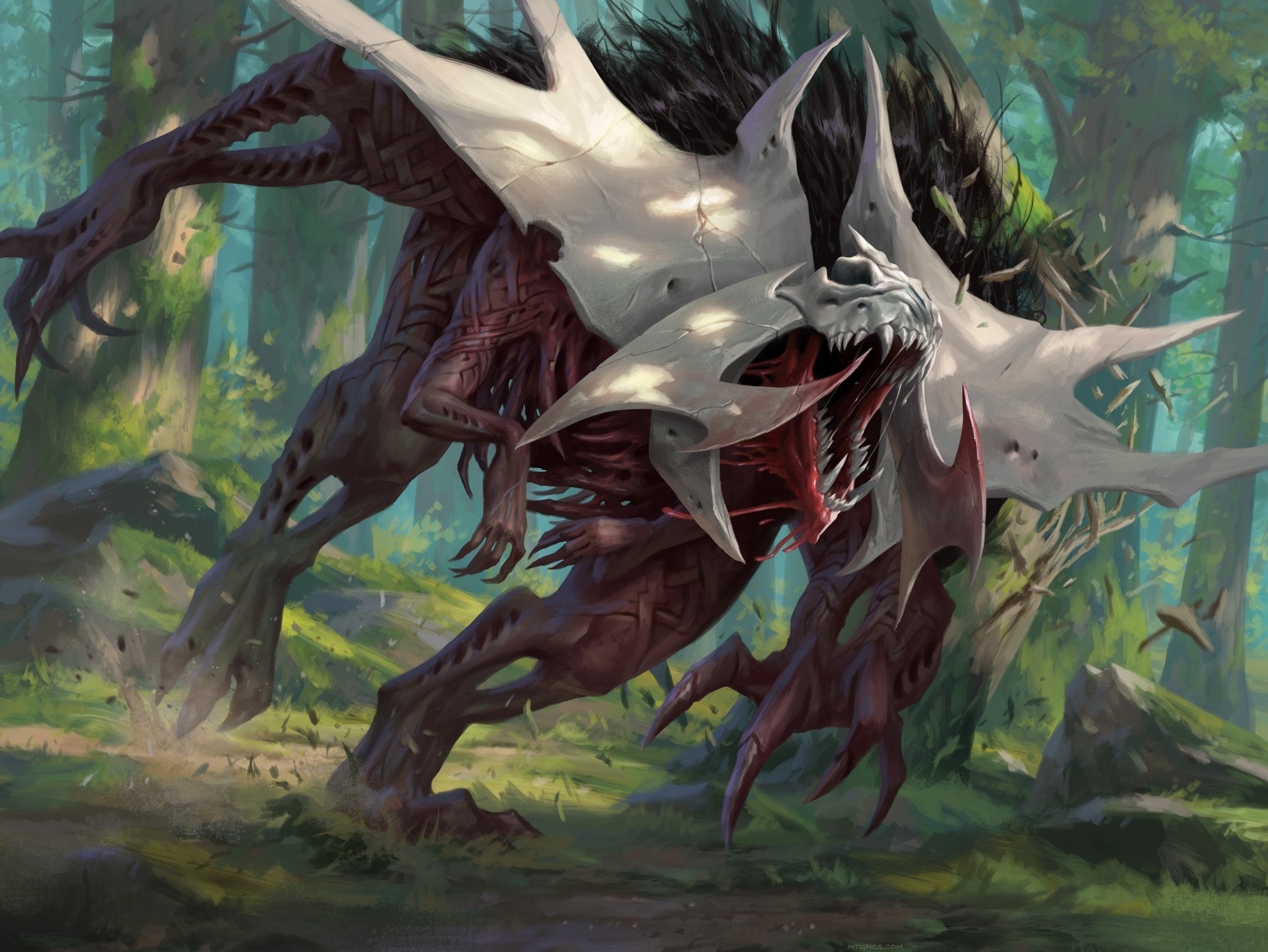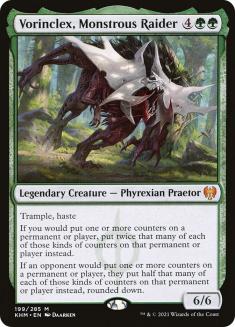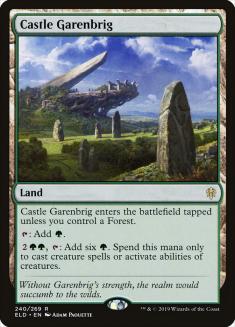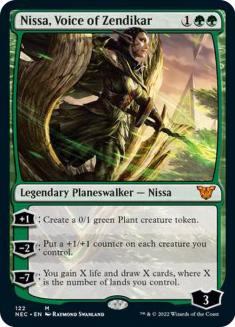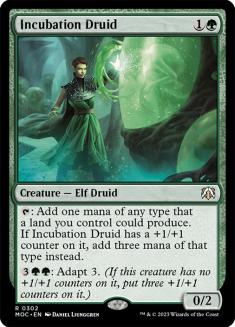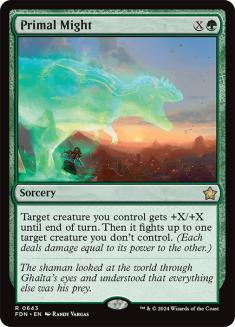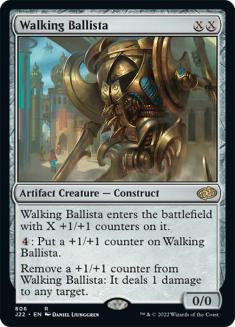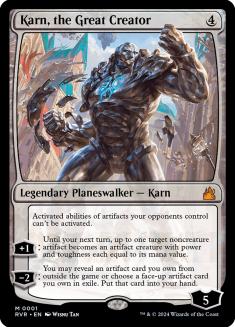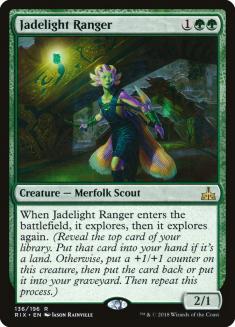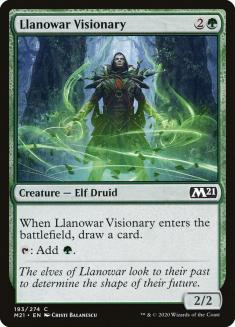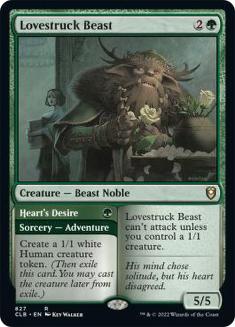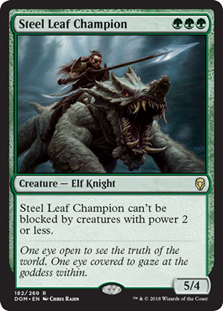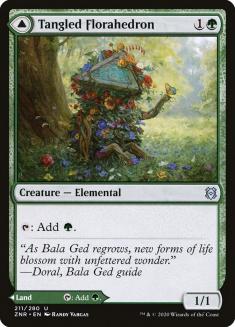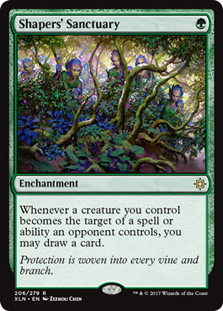I’ve been really into Pioneer over the last few weeks. The bannings shook up a lot of formats, and most of them seem to be doing much better as a result. I’m happy for that fact, and will continue applauding Wizards of the Coast (WotC) when they make decisions that improve quality of life.
Older formats like Modern, Pioneer, and Legacy got some much-needed love, but I understand the hesitancy. Being too aggressive means customers losing investments; too passive, and formats stagnate. It’s is a hard line to balance, but I feel like the most recent banning was on the money. To celebrate, I’ve been playing Pioneer again!
This week’s article will focus on the advancement of Mono-Green Devotion in Pioneer thanks to the inclusion of Vorinclex, Monstrous Raider. If that’s your jam, then strap in. This ride is about to get bumpy. If that’s not your thing, that’s okay too. PVDDR probably has you covered!
If you’ve played Mono-Green Devotion before, you’ll notice many of the major players are still bumping around. Even though a few cards have been banned, and one unbanned, most of the core has stayed intact. Your goal is to quickly accelerate with Llanowar Elves and Elvish Mystic into powerful late-game spells. The rest of the players change with regularity, but Vorinclex might throw all that out the window.
This cookie-cutter combo had me shakin’ the first time I saw it. On paper, Castle Garenbrig should be broken with powerful six-drop green creatures. Skipping the five-drop slot entirely to focus on Castle Garenbrig and six-drops just makes sense when those six-drops are as powerful as Vorinclex, Monstrous Raider. In actuality, we’ve had a dearth of six-drop green creatures in Pioneer to pair with Castle Garenbrig, but that’s all about to change.
One aspect of Vorinclex, Monstrous Raider that I initially overlooked was how strong a large, hasty, trample creature could be by its lonesome. Without any help, Vorinclex beats down for chunks of damage. Trample means you can bury an opposing planeswalker without much resistance. Haste means you can cast it after a sweeper and put your opponent in the ground. A 6/6 is bigger than most creatures that see play in the format, so you’ll be rumbling in just about every time you cast it. It might as well enter the battlefield tapped and attacking.
To be clear, this is what Vorinclex does before you start pairing it with cards that produce +1/+1 or loyalty counters and before you realize just how devastating his oppressive ability is against some opponents. When you play your first mirror and cast Vorinclex, you’ll understand just how weak all of your opponent’s cards become.
Halving Voracious Hydra or reducing the effectiveness of their planeswalkers is absurd, but it comes with a steep price. Six-mana creatures don’t often see play in Constructed formats, so when one like Vorinclex comes along and easily fits into multiple archetypes in multiple formats, you should start paying attention. The fact that we have Castle Garenbrig just makes bridging the gap to six mana a good bit easier.
There is some tension between Castle Garenbrig and Nykthos, Shrine to Nyx. Playing four copies of both means playing fewer copies of Forest, which leads to Castle Garenbrig entering the battlefield tapped on occasion. Formats like Pioneer are fast enough that having a land enter the battlefield tapped on the wrong turn can be enough to end the game on the spot. Drawing multiple copies of Castle Garenbrig isn’t so bad because they’re not legendary, but a second one does little more than act like a Forest.
Because of this, I expect the “correct” number to be either two or three, but I certainly wouldn’t blame you for just jamming four. It’s been incredible with Vorinclex and Voracious Hydra, giving you that extra burst of mana at just the right time and on the right turn. I’ve only had two in the deck for the longest time, but I vividly remember the moments in which Castle Garenbrig made my Voracious Hydra one bigger than it should’ve been, and that one point being all the difference in whether or not I could take their creature down.
Anywho, let’s get to the current list.
Creatures (22)
- 4 Llanowar Elves
- 4 Burning-Tree Emissary
- 4 Elvish Mystic
- 3 Incubation Druid
- 4 Voracious Hydra
- 3 Vorinclex, Monstrous Raider
Planeswalkers (12)
Lands (22)
Spells (4)

Nissa, Voice of Zendikar is one of the cheaper burst options to combo with Vorinclex. Unlike Hardened Scales, Vorinclex doubles the counters on Nissa at every point, including when you cast it. Putting it into ultimate range at low effort makes it stronger in later turns where it might not be a great draw.
The minus ability doubling on the turn you cast Vorinclex makes swinging for lethal a paltry task. The minus ability on Nissa is already nuts. Doubling up those counters can turn weak draws featuring too many mana creatures and Burning-Tree Emissary into something much more sinister.
In the Hardened Scales decks that skirted around the format a while back, Nissa, Voice of Zendikar was one of your best spells because it was one of the cheapest ways to generate counters for multiple creatures at once. The fact that you can kinda set it up by casting it first, followed by Winding Constrictor (and maybe another play) on the next turn meant developing in stages as opposed to needing everything online at once.
Nissa, Voice of Zendikar is plenty good on its own, generating threats over time and working well with our new shiny Phyrexian. Nissa has the capability to turn some of our weaker creature-heavy draws into somewhat desirable starts, and she makes it feel effortless.
Filling in the role of Wolfwillow Haven, Incubation Druid has the potential to be one of the sleeper cards for this archetype. For one, we’re always clamoring for mana producers, and having those creature do something else when you enter the late stages of the game is a huge bonus. Incubation Druid can give you a mana outlet, almost like a kicker, to turn it from a mana creature into something larger.
The downside of playing Incubation Druid over Wolfwillow Haven is that your two-mana accelerator is vulnerable to a host of removal effects. Having Wolfwillow Haven always ramp you in the face of one- and two-mana removal means you get to circumvent the part of the game where your opponent’s interaction gets to slow you down. Instead, you get right to your planeswalkers, which are harder to deal with and turn your little creatures into slightly larger creatures.
While I think Wolfwillow Haven was better in previous incarnations, Incubation Druid might supplant it permanently if this build becomes the norm. Why?
Nissa, Voice of Zendikar and Vivien, Arkbow Ranger can pump it, and adding a counter to Incubation Druid makes it incredible. That burst of mana means you’ll be doing some degenerate stuff quickly. You don’t have to use adapt to gain the ability!
Primal Might is one of the only standouts because it’s new, but I’ve seen it do some disgusting things to people caught unaware. In a pinch, it’s just Prey Upon, which is about as good as it gets for cheap removal in the color green. I might be in the mood for a Hornet Sting if they ever reprint it. Until then, I’m gonna play the Fireball that kills their kills their biggest creature.
So What’s Missing?
The loss of Walking Ballista is more apparent here than ever before. Already one of the better cards in Mono-Green Devotion, it would be particularly disgusting in a shell featuring Nissa, Voice of Zendikar and Vorinclex, Monstrous Raider. Hell, if Walking Ballista were in the format, I might even find a way to jam Hardened Scales into the mix! It’s been a while now since we lost the Construct, but I miss it a little more each time I tap a Nykthos.
BRB. Pouring one out for the realest.
Karn, the Great Creator has been a mainstay in this archetype for a while now, if only because we needed something to fill the Walking Ballista-sized hole in my heart. The modal nature of Karn, and Walking Ballista before it, was always the draw. It acted like a toolbox that grabbed some really neat artifacts from the sideboard that could help you out of many situations. Combined with Vivien, Arkbow Ranger, your entire sideboard could be a toolbox if you wanted, meaning you never actually had to think about sideboarding. What a relief! The only thing Karn asks of you is mana. Mana to play Karn, and mana to cast the stuff that Karn grabs.
The inclusion of Vorinclex necessitates that we build the deck differently. Vorinclex works wonderfully with most of your planeswalkers, but there was no remarkable difference in how it played with Karn. That’s mostly due to the static nature of Karn’s effects, which mostly revolve around being powerful when you have access to a ton of mana. With Vorinclex already on the battlefield, casting Karn doesn’t do much other than the stuff it already does, which is not the case with the other planeswalkers.
Losing Karn means we also gain a sideboard. I do love keeping at least two or three tutor creatures for Vivien, Arkbow Ranger, but getting those lost slots back can help in some of our tougher matchups. Having two or three sideboard cards for two or three different popular archetypes could result in a dramatic shift in win percentage among our tougher adversaries.
These two cards have been fighting for the three-drop slot for a long time now. Before Vorinclex, I think Jadelight Ranger had the edge. Now, I’m not so sure. The acceleration of Llanowar Visionary works nicely with Castle Garenbrig, but hitting two lands on Jadelight Ranger just felt so incredible. In some spots, the extra power on Jadelight Ranger was clutch, as Vivien, Arkbow Ranger is always looking for targets to boost. The bigger they start, the trickier combat becomes for the opponent.
For now, I’m going to stick with Nissa, Voice of Zendikar. I’ll be coming back for these two should our deck change in any meaninful way. I know what both bring to the table, and I know they’re reliable. If I find myself with too much raw power and not enough consistency, cards like Jadelight Ranger and Llanowar Visionary are just the ticket to reel it back. Big Civic Wayfinder vibes.
Another Look
Vorinclex is one of those cards that’s so powerful you forget that it’s unnecessary to build your deck completely around it. You need a nice balance of raw power and power through synergy, and finding that balance in your cards is the equilibrium that every deckbuilder strives for. It’s such a sick feeling to topdeck a spell that works well on its own, but you find so many messed-up spots for it when Vorinclex or one of your planeswalkers gets into the mix.
So that had me thinking all day about how we could build a version of Mono-Green Devotion to put Vorinclex into the fray but not have it be a focal point. Instead of a behemoth that makes all your bad cards into good cards, what about a deck full of powerful stuff that might get a little better when you play this sweet mythic rare?
Creatures (28)
- 4 Llanowar Elves
- 4 Burning-Tree Emissary
- 4 Elvish Mystic
- 4 Steel Leaf Champion
- 3 Voracious Hydra
- 4 Lovestruck Beast
- 2 Tangled Florahedron
- 3 Vorinclex, Monstrous Raider
Planeswalkers (4)
Lands (22)
Spells (6)

This deck failed my standards for recommendation. I like posting versions of decks that didn’t work out because I get to tell you why they didn’t work out, as well as what ideas inside the experiment ended up pulling their weight. In this breakdown, we get to do both!
I have grown quite fond of Lovestruck Beast over the last year and change. It’s been a major part of Pioneer and Standard, giving new life to the aggressive side of green’s alignment. More stompy, less rampy. That’s usually what Lovestruck Beast is all about. However, it turns out that Llanowar Elves and company are pretty good at being the 1/1 body for Lovestruck Beast. That means your 5/5 gets to attack with more regularity in the face of cheap removal.
Lovestruck Beast also blocks. As someone who’s played a lot of Mono-Red Aggro in both Standard and Pioneer, Lovestruck Beast has been the bane of my existence. If my opponent casts Heart’s Desire on the play, I assume I’ve lost. Part of the reason why is that blocking actually matters on this card, which is rare in Magic these days but particularly detrimental to traditional aggro decks with low evasion counts. Creatures “getting to block” is so often blown out by Atarka’s Command, Embercleave, or just plain old spot removal. Why would you build your deck to be good at blocking when it comes up so rarely?
I love that Lovestruck Beast is good at blocking. I love that it’s an efficient beater for three mana. I love that it provides you with some resiliency in the face of removal spells. I love that it powers out The Great Henge, offering a bit of diversity in gameplay and creating a sense of urgency for the opponent to interact.
The games revolving around The Great Henge being stuck in hand are some of the most frustrating, yet also some of the most interesting. Navigating those waters against a competent opponent wielding a number of removal spells is rewarding when it pans out. Lovestruck Beast is not a good card for Mono-Green Devotion.
I was actually impressed by how well Steel Leaf Champion fit into the archetype. It paired nicely with Vivien, Arkbow Ranger’s “bite” ability, gave three points of devotion for Nykthos, and gave you some real power on the second turn without significant investment. If you just slammed with a bunch of big bodies over and over, your opponent is prone to tapping out or needing something outrageous to match your squad. Supreme Verdict or bust, baby.
Steel Leaf Champion does not work that well in a ramp deck and has no real synergy with anything else. It’s a ruse. It’s a false positive. It’s a great creature from a different type of green deck that got lost and wandered over. Steel Leaf Champion and Lovestruck Beast both deserve to be happy, and they can do so in a different deck. Possibly one that brings The Great Henge along with it, or maybe just a Stubborn Denial or three. I don’t care. Just leave me out of it.
Not bad, but would not recommend. The synergy between Nissa, Voice of Zendikar and Incubation Druid just widens the gap for me. They’re both lackluster in their own ways, and contain the inner qualities to grow in strength when combined with other elements, but a tapped land in this deck was not great and there is no great payoff on the front side of your tapped Forest.
I drew this once after my opponent killed all my creatures. Never doing that again.
An Earnest Assessment of Vorinclex, Monstrous Raider
It’s six mana, folks. That’s a lot of mana, so you need to expect a big effect. I’ve tried Ulvenwald Hydra with Castle Garenbrig in Pioneer before, and it was fine but not great. Ramping into a big creature that gets you even more mana to cast even more big creatures is just the same thing as playing Ponder into Preordain and passing the turn. You’re doing something but you’re not affecting the battlefield in a meaningful way. You’ve capped out on “big dumb creatures” and need something that hits a little differently. In Pioneer specifically, there aren’t many great six-drop green creatures worth mentioning. Most of the good ones were printed in the last two years or have X in their casting cost. The other options just fell a little flat.
[Enter villain; cue the music.]
The first time I cast Vorinclex, Monstrous Raider, I knew we had something special. I don’t want to sound corny or whatever, but I actually felt the power of Vorinclex surging through my veins. Every part of the beast came to life, from the brutal speed to the amplification of all your best elements. I summoned a Praetor, and it was everything I needed it to be. Six mana is a hefty amount for a creature, but all you need is for that threat to easily secure the bag when you’re ahead or potentially catch you up when you’re behind. Vorinclex has the capability to shut down entire archetypes. What else is there to say?
I can’t in good conscience recommend anything other than moving toward this new normal. The pieces might change, but Vorinclex should become a member of the core components. It’s simply incredible. In five years, Vorinclex will be a name we speak of fondly. We’ll place it in the annals of the Magic greats alongside Jace, the Mind Sculptor; Wrath of God; and Flametongue Kavu. It is the embodiment of green in all the right ways.
I absolutely love it.

